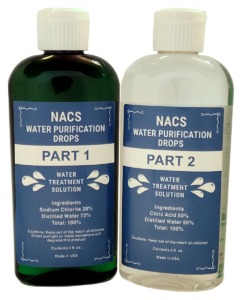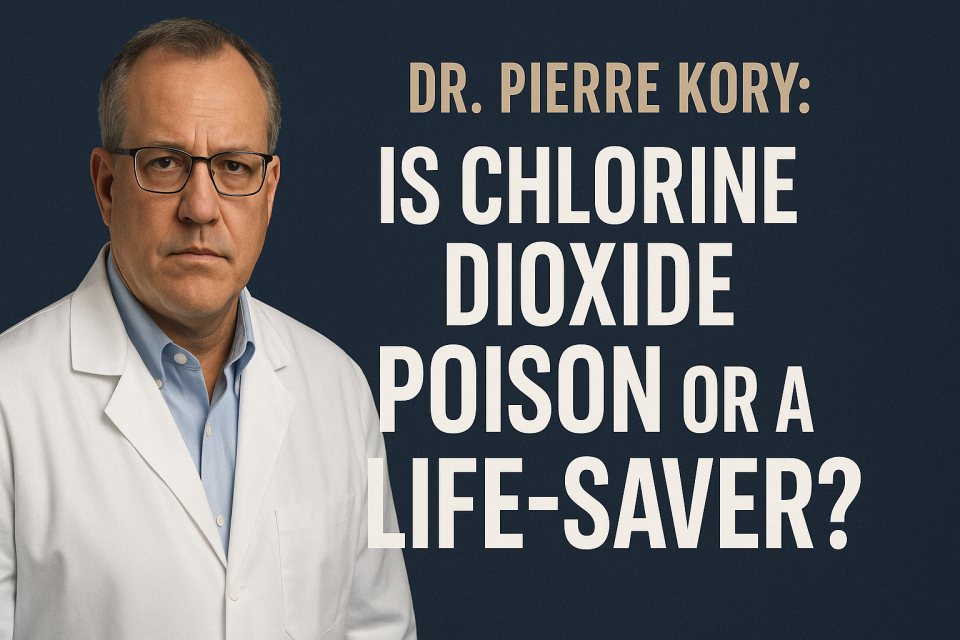In a medical environment dominated by pharmaceutical interests and regulatory gatekeeping, few topics spark as much controversy as chlorine dioxide. Long dismissed by mainstream health agencies as nothing more than an industrial disinfectant or “bleach,” this compound has been quietly gaining attention from researchers, doctors, and patients around the world for its potential therapeutic uses. One of the leaders of the charge to reassess chlorine dioxide’s role in modern medicine is Dr. Pierre Kory, a critical care specialist known for his willingness to challenge medical orthodoxy during the COVID-19 pandemic.
In his recent article, “The Existing Evidence Base For Chlorine Dioxide In Treating Human Diseases,” Dr. Kory presents a compelling argument: that chlorine dioxide, when used at appropriate therapeutic doses, may offer broad-spectrum benefits in treating infections, inflammatory conditions, and even chronic illnesses like cancer. Drawing on clinical observations, international case studies, and the compound’s misunderstood safety profile, he makes the case for reevaluating chlorine dioxide not as a fringe remedy but as a substance worthy of serious scientific exploration. This summary dives deep into Dr. Kory’s findings and the broader implications of his call for uncensored, evidence-based research.
Dr. Pierre Kory, a respected critical care physician known for his advocacy of early treatment approaches during the COVID-19 pandemic, presents a detailed and cautiously optimistic review of chlorine dioxide (ClO₂) as a potential therapeutic agent. His report is not a wholesale endorsement but a call for open, unbiased scientific inquiry into a compound he believes has been unfairly maligned and prematurely dismissed by regulatory and medical institutions.
- Purpose of the Article
Dr. Kory clearly states that his intention is not to promote chlorine dioxide as a cure-all or bypass proper medical scrutiny. Instead, his purpose is:
- To highlight the current scientific evidence and anecdotal reports.
- To critique the regulatory overreach and suppression of research.
- To encourage open-minded clinical investigation without political or corporate interference.
He writes with the conviction that suppression of potentially beneficial compounds like chlorine dioxide reflects a broken system of scientific censorship driven more by commercial and political interests than by true health outcomes.
- Regulatory Suppression and Mischaracterization
Dr. Kory discusses how agencies like the FDA, CDC, and WHO have labeled chlorine dioxide as a “bleach” or “toxic poison,” associating it with industrial use rather than considering its therapeutic potential at low concentrations.
- The EPA’s own documents acknowledge chlorine dioxide safety at levels below 0.8 mg/L in drinking water—a concentration well above what is typically used therapeutically.
- He contrasts this with the alarmist language used in FDA warnings, which fail to distinguish between therapeutic-grade ClO₂ and industrial-strength solutions.
- Kory argues that such mischaracterizations chill research, discourage doctors, and marginalize patients who have reported improvements.

- Distinguishing Chlorite from Chlorine Dioxide
The article clarifies a common point of confusion:
- Chlorite and chlorine dioxide are distinct chemical species.
- Most of the available clinical studies that skeptics often cite examine chlorite, not chlorine dioxide.
- Despite this, regulators often conflate the two, further clouding the public and scientific understanding of ClO₂’s safety and efficacy.
- Evidence Supporting Chlorine Dioxide Use
While Dr. Kory admits that more double-blind, randomized controlled trials are needed, he provides a robust list of observational studies, case reports, government programs, and historical uses suggesting therapeutic promise. Highlights include:
Malaria
- A field study in Uganda allegedly demonstrated 100% parasite clearance in malaria patients after administration of chlorine dioxide.
- While not peer-reviewed in the traditional sense, the outcomes suggest a need for formal trials.
COVID-19
- During the pandemic, Bolivia legalized chlorine dioxide as an emergency treatment.
- According to Kory, some Bolivian municipalities saw significantly reduced hospitalization and death rates compared to neighboring regions.
- He notes that these results were ignored or ridiculed by the international press and scientific community without investigation.
Other Conditions
He references reported or emerging use in the treatment of:
- Respiratory infections in children
- Dengue
- Tuberculosis
- Cancer (preliminary lab and anecdotal evidence)
- Autoimmune disorders
In each case, Kory emphasizes that the evidence, while not yet definitive, merits deeper study, not dismissal.
- Safety Profile and Misleading Toxicity Claims
Dr. Kory disputes the widespread claim that chlorine dioxide is inherently dangerous. He supports his counterargument with:
- Data from EPA toxicology reviews show no adverse effects at or below 0.8 mg/L.
- Anecdotal evidence from millions of users worldwide who use it for water purification, sanitation, and personal health, with very few documented adverse events.
- Clinical experience from physicians and researchers (particularly in Latin America) who have administered it successfully without significant side effects.
He strongly suggests that the dose makes the poison, and therapeutic use is far below toxic thresholds.
- Systemic Scientific Censorship
A central theme of the article is the systemic suppression of promising, low-cost medical alternatives. According to Dr. Kory:
- The pharmaceutical industry has no incentive to support research into substances like chlorine dioxide because they cannot be patented.
- Regulatory and academic institutions—often influenced by pharmaceutical funding—play along, sidelining cheap, natural, or off-patent treatments.
- This reflects a larger epistemological crisis in medicine where truth is defined by consensus and commercial interests, not by evidence and outcomes.
- Call to Action
Dr. Kory closes with an appeal to the medical and scientific community:
“Do not allow scientific exploration to be silenced because of politics, money, or media distortion. The body of evidence supporting chlorine dioxide—while imperfect—is compelling enough to warrant rigorous, unbiased clinical trials.”
He challenges researchers and institutions to examine chlorine dioxide with the same scientific rigor and fairness applied to any other compound with therapeutic potential.
Conclusion
Dr. Kory’s report is a measured, evidence-based, and principled challenge to the prevailing narrative on chlorine dioxide. It does not declare chlorine dioxide a miracle cure, but it calls out the injustice of preemptively banning or ridiculing it without proper scientific vetting.
His message is clear: chlorine dioxide is not bleach, and it may offer a powerful and affordable treatment option for many diseases. The only way to know is through honest science, free of censorship, stigma, and special interests.
Reference:
“The Existing Evidence Base for Chlorine Dioxide.” Analysis by Dr. Pierre Kory. You can follow Dr. Kory at: Pierre Kory’s Medical Musings
